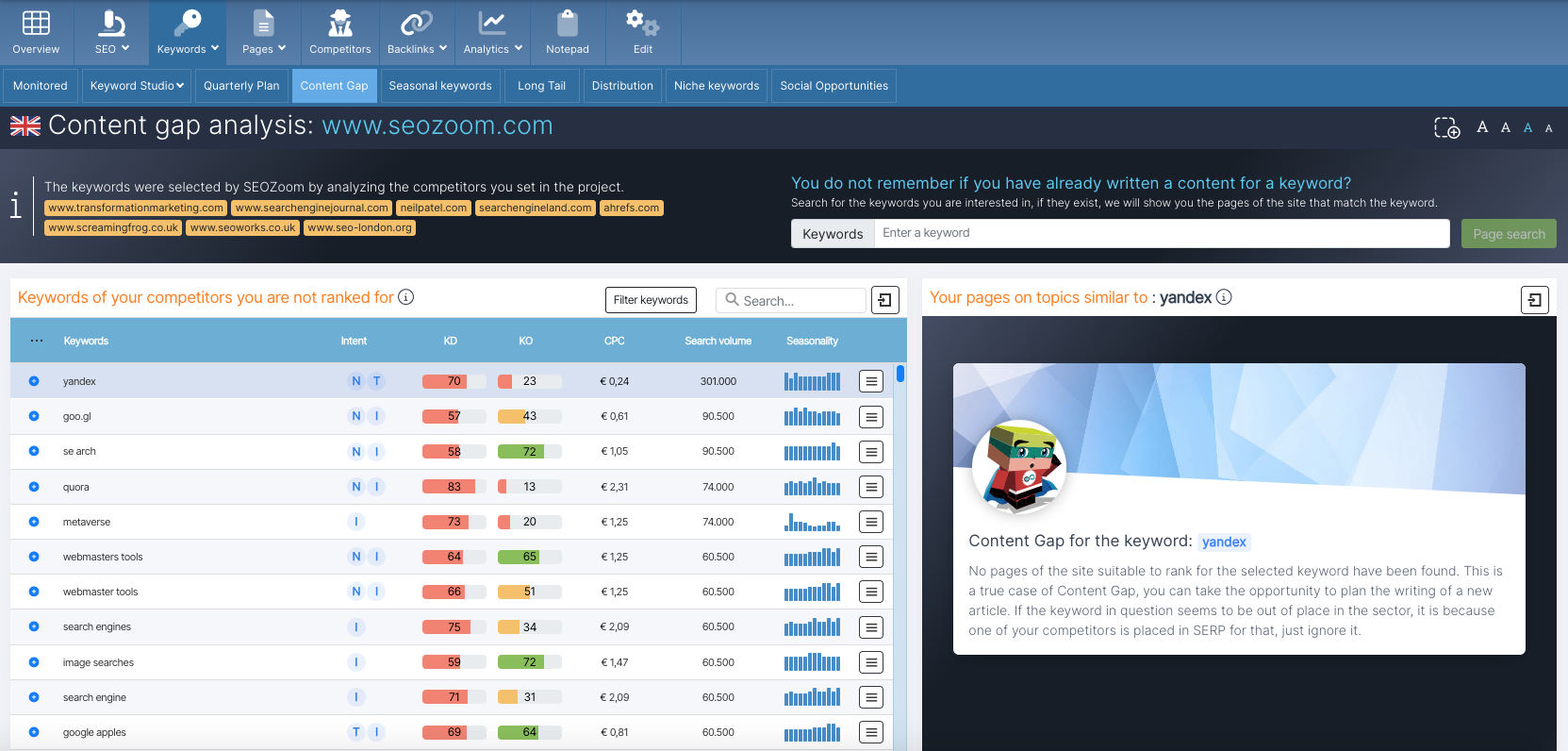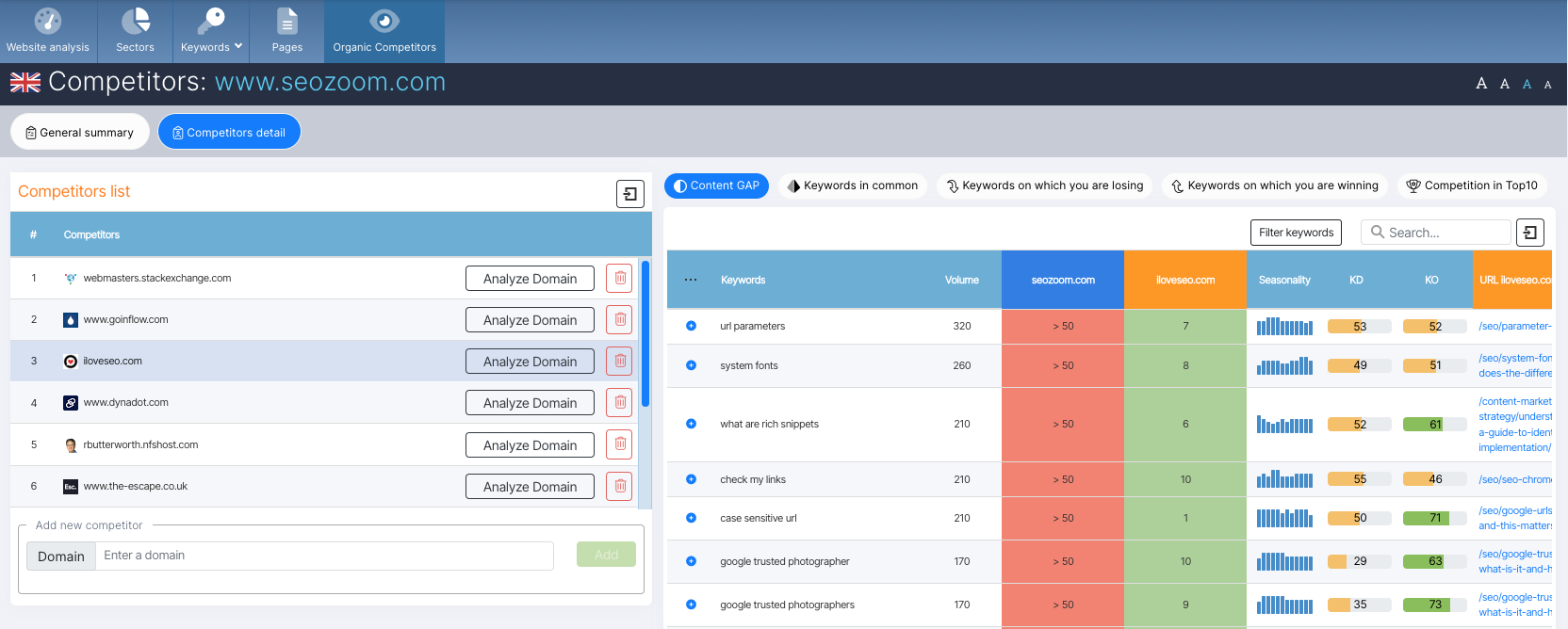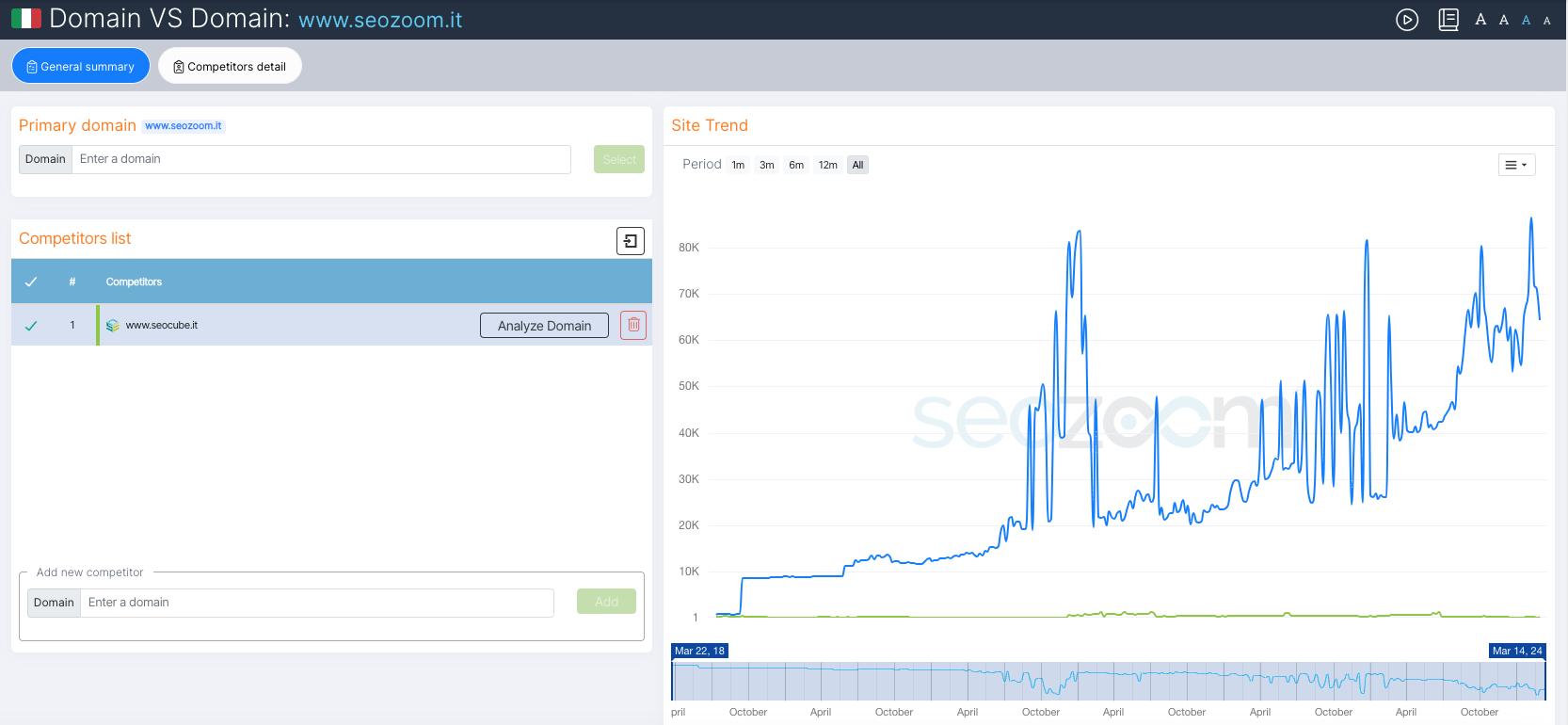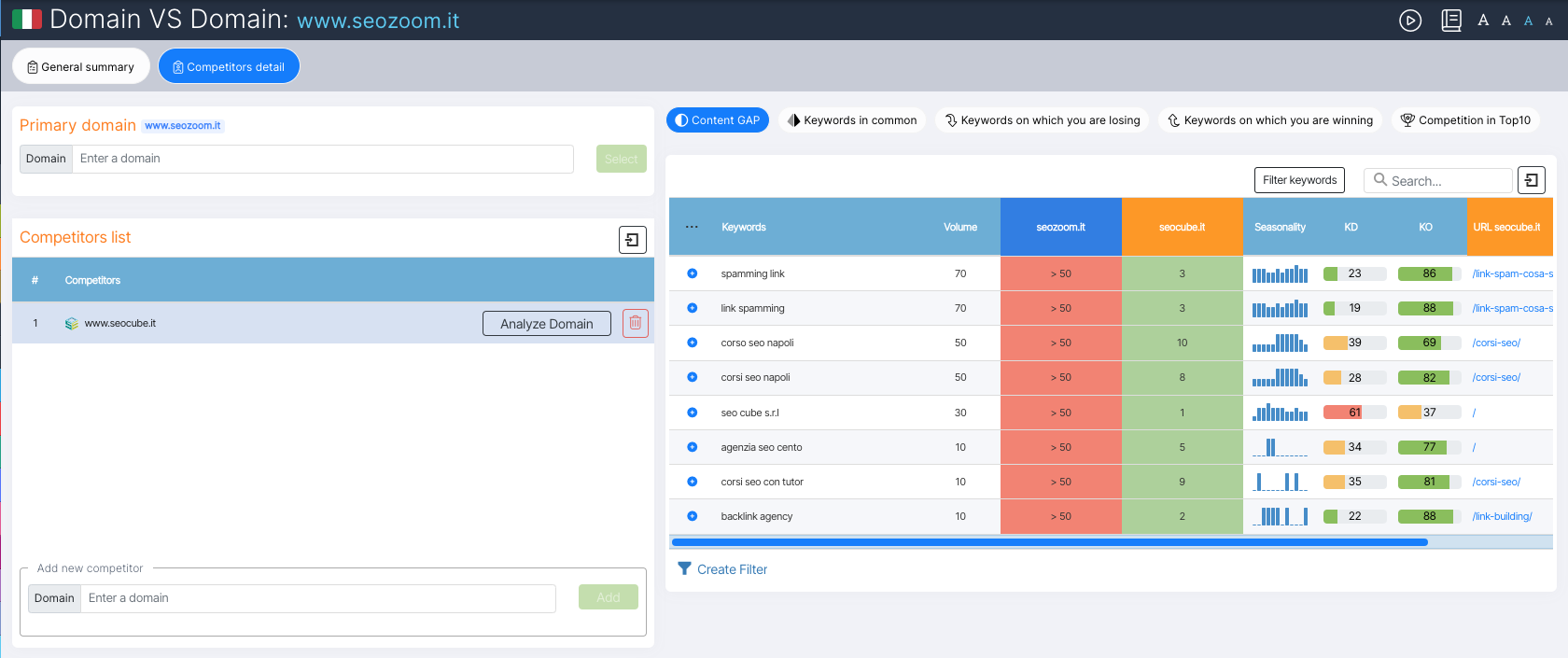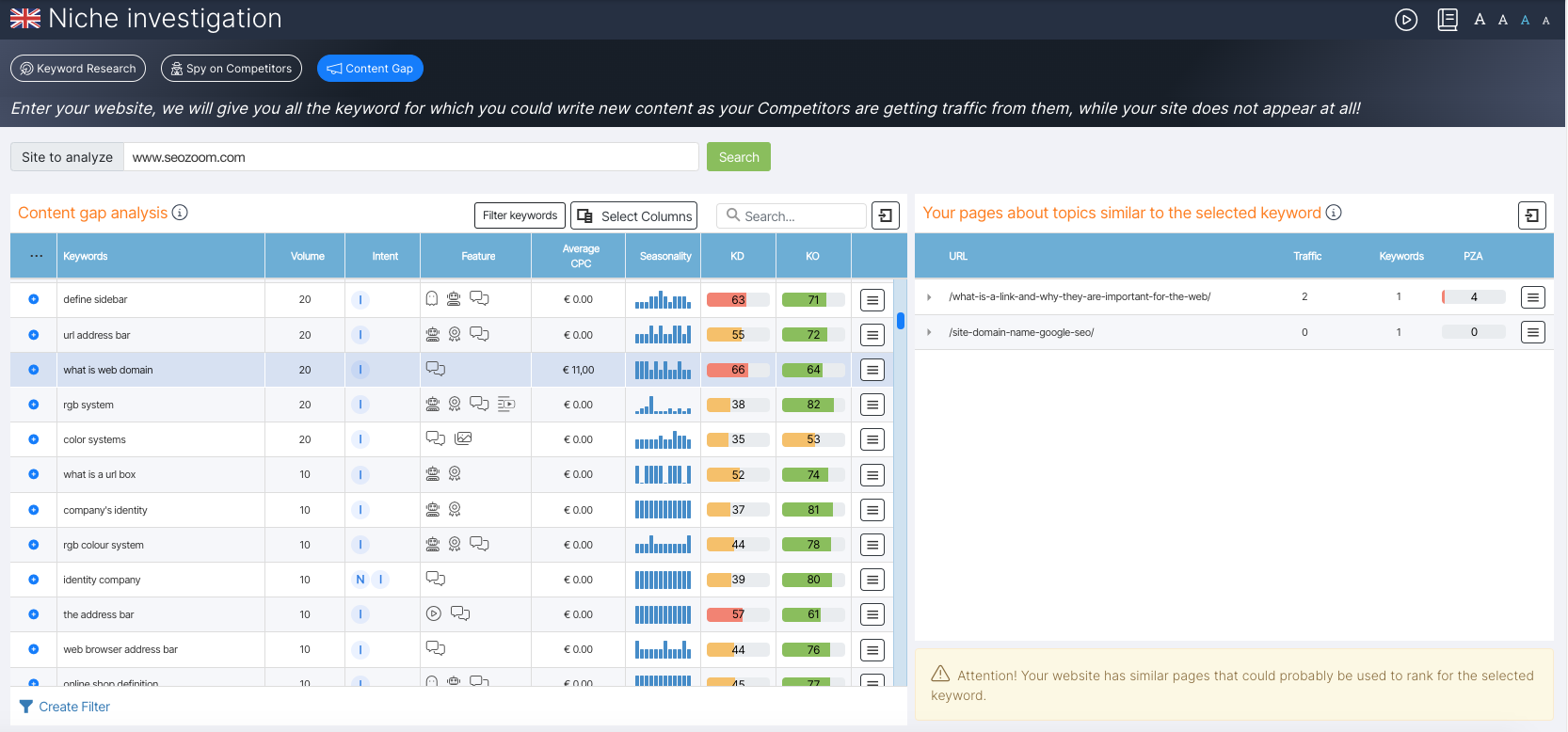Content gap analysis, how to steal traffic from your competitors
There is a quick and fast technique for stealing traffic from our competitors – sure, the chosen verb is not elegant, perhaps, but it describes what we more or less do all the time in editorial activities. We talk about content gap analysis, a strategy that allows us to find new insights and ideas for our editorial plan by analyzing the keywords that people search for and that bring more traffic to our direct competitors. It is therefore about identifying and filling the information “gaps” that exist between our site and those of our competitors, which represent “holes” that our opponents exploit instead, to try to turn around and stop missing profitable opportunities.
What content gap analysis is and what it is for
Content gap analysis is a research process that allows us to find out what topics or keywords our competitors are covering effectively, while we are not.
Performing a content gap analysis is a smart way to identify “gaps” in our content and get insights to turn into strategic content that will attract more traffic, will convert more customers and provide even more value to our target audience.
In essence, this process helps us find the keywords for which our competitors rank in SERPs while our website is absent.
Win over your competitors’ traffic
The meaning of gap analysis
In journalistic jargon, it is defined gap when the newspaper does not cover a very relevant news that is instead spoken about in other competitor newspapers; basically, it is the opposite of the scoop – an exclusive piece of news from just one newspaper – and it is considered one of the biggest mistakes the editors can make, because it directs readers to competitors in search of the information that has aroused so much interest.
The same mechanism also applies to editorial content on the Web, where the expression content gap is used to indicate precisely the content (relevant topics and keyword) that are absent on a site and that are well treated by its competitors, placing its pages on Google and thus conquering the visits and conversions of users.
More generally, gap analysis or gap analysis is a methodology used in management to assess and identify the difference (precisely the “gap”) between an organization’s current situation and its desired future goals. This type of analysis focuses on various aspects of business operations, such as performance, competencies, processes, and technologies, and aims is to detect areas that need improvement to enable the company to reach its ideal state.
Content gap analysis: improving ranking by studying competitors
Content gap analysis is a process for discovering content ideas that are missing from our website but are instead covered by the pages of our main competitors, which indeed get relevant organic traffic from them. The analysis can cover landing pages, social media, downloadable content, and any other content we own, but it usually focuses on the blog or site as a whole, to optimize the level of content offered and, at the same time, the way we guide visitors through each stage of their journey.
After all, we can assume with sufficient confidence that most companies or people using any kind of SEO tactics usually publish content with the goal of getting on the first page of Google.
In many cases, however, we risk deploying a scattershot and unhelpful strategy: we do keyword research to look for the topics that seem potentially most interesting, perhaps launch a quick comparison with some of the competitors, and then work on producing content to publish on the site.
In fact, starting by studying what is already available for the major keywords allows us to easily and quickly come up with many ideas about what content to create next, and it is a more direct and effective way to know (at least roughly) what kind of content the search engine likes because it is most relevant to the users’ needs-in other words, what features can increase the chances of getting that ranking.
With content gap analysis, in fact, we can gain valuable data and insights to devise a more targeted content strategy, identifying unexplored opportunities and answering questions that our audience is asking but we have not yet addressed. It also helps us better understand our target audience and strengthen our online presence by serving content that addresses specific information needs.
Why content gap analysis is useful
In summary, this work is useful because it allows us to better align with users’ search intentions and respond more effectively to their needs, while obviously producing perfect content that offers added value that sets us apart from our competitors.
It also helps us optimize our editorial calendar, investing resources in content that is more likely to generate qualified traffic and conversions.
More specifically, a content gap analysis can bring us a number of benefits, including:
- Identifying which topics and types of content are missing on our site, identifying where we are missing crucial content for customers moving along their journey, junctures where people could easily leave and directly prefer a competitor with more relevant information.
- Discovering topics that connect and resonate with our target audience.
- Finding gaps in our strategy, to be filled with quality content: strengthening SEO will improve site authority, attracting new leads and customers to our business.
- The content gap analysis process involves setting concrete goals, deeply understanding Buyer Personas, mapping the buyer’s journey, performing market and competitor research, and conducting an audit of our content assets.
After identifying gaps, we can fill them and develop fresh, relevant and engaging content that audiences will appreciate.
Gap analysis also allows us to make the customer journey smoother and easier to follow by enabling more holistic and connected experiences that meet people’s needs at every stage and help them move more quickly through the sales funnel.
This audit of content present on competitor sites, but absent on our pages, allows us to identify gaps and underperforming parts of our site’s content; in particular, we can focus on analyzing aspects such as:
- Content freshness – when the content was last published or updated.
- Completeness – does the page provide the user with all the details they might be interested in to complete their goal and intent.
- Unanswered questions – absence of crucial information.
- Usability – the user can easily read and understand what is on the page.
- User intent – level of satisfaction with the user intent.
- Wow factor – degree of liking, interest and engagement of the content, such that it encourages sharing by users.
How to perform a content gap analysis
There are several ways to perform an effective content gap analysis with which to keep an eye on competitor strategies, verify our content strategy and improve site SEO: with SEOZoom we have a set of tools that accompany us in this process in the area dedicated to the Competition, in addition to a more specific function called Content Gap which, as we will closely see, allows you to understand what is missing from our content to be really responding to the search intent identified by Google.
But there are also other methods to perform this analysis, and Alex Valencia on Search Engine Journal offers us his advice to locate the holes in content on our site, fill them up and earn positions and traffic on Google.
Prima di lanciarci a capofitto nel processo, però, è importante soffermarci sull’analisi preventiva di alcuni prerequisiti, e in particolare identificare in anticipo gli obiettivi primari che vorremmo raggiungere e comprendere con precisione chi è il pubblico di destinazione a cui facciamo riferimento e che vogliamo intercettare.
On the goals side, we need to ask ourselves why we are analyzing our site’s content comparing it to our competitors‘ content, and then again predict what we hope to achieve through this process and what we want to improve; goals could focus on traffic, leads, search engine rankings, and anything else that will help us improve your content marketing strategy and get better results.
On the target audience side, on the other hand, we first need to be aware of how well we know our target audience, what their level of interaction with the site and content is, and then map Buyer Personas by identifying elements such as basic demographics, interests, needs, behavioral traits, challenges and weaknesses.
Detecting and fixing content gaps
According to the expert, to be effective the content gap analysis must lead to the identification of missing parts of content that could and should align with the various stages of the customer journey of the target audience. Working in this way, we will find holes to fill with new content, which will make it easier for users to find our site and buy our products.
The first step is to analyze the proposal of existing content, which allows us to see where we risk losing valuable resources that “could drive readers to the point of purchase”followed by the identification of new keyword opportunities that we are currently not exploiting with existing content.
In general, an analysis of the gaps in the content provides an audit on:
- Web pages.
- Blog articles.
- Social media content.
- Landing page.
- Ebooks and downloadable resources.
- Other content assets.
Mapping content to the buyer’s journey
Not all visitors “who access our website will be ready for purchase”, the author recalls: often they are simply looking for information, want to compare their options or make purchases for the best solution.
Our goal is therefore to try to create content for each stage of the buyer’s journey, whether it is the awareness of problems, the awareness of the solution or the final one of its purchase path.
Many brands focus on creating informative content in the form of blog posts to attract a wider audience and pages “money” to convert those users into buyers: however, this strategy can create a gap for people who are still considering various options and therefore do not find what they need.
Organizing content for the funnel
In conducting the content gap analysis, the expert recommends identifying the presence of content for the classic phases of the funnel – Awareness, Consideration, Decision and Success – for each of the offers of our website (services, products, form compilations, downloads and so on), so that users do not fall into these “holes”.
The awareness pages are built around keyword related to a problem that the audience is facing: these contents help to address this problem and offer valuable information, but do not immediately convert the reader into a customer.
In the consideration phase, people are comparing various solutions to their problem and may therefore be interested in reading comparative guides, reviews or posts with the “best of”. We can create content that compares our service/ product with that of competitors, or simply propose our brand as one of the many solutions in a round-up post (a post collecting opinions or reviews on a topic/ product/ service).
The decision-making stage is where most of the “money” pages are located, such as sales pages or service pages, which serve as the final checkpoint before a user completes the purchase or requests a contact. These pages need to be more brandished than the previous ones.
Finally, the content for the success phase serves to reassure customers who will get the desired result: fall into this category a simple thank you page or a more complex sequence of follow-up e-mail that connects users with continuous support or asks them for feedback.
The 4 steps to make a content gap analysis
The work of content gap analysis is not simply to sift through blog posts to find out if we are losing ideas for tantalizing content: Valencia then accompanies us in a step-by-step process in search of obvious holes in our content, explaining the 4 steps to fill gaps and achieve a better content strategy.
- Mapping the user’s path
The author suggests starting with the mapping of the buyer’s path, to identify the steps that the audience must perform to switch from A to B to C: in practice, this means literally drawing or writing the main questions of the audience, the various options they might consider, what they are looking for before buying and what call to action they are most likely to urge them to contact us.
For example:
- The owner of a small business may find it difficult to make ends meet.
- Keeping this issue in mind, look for “how to manage the finances of my small business”.
- This produces several articles that talk about the “X best ways to manage business finances”. Click on an article titled “10 methods to control the finances of small businesses”.
- This article provides 10 useful tips, one of which is using an online accounting and administration software.
- The business owner goes back to Google and searches for “the best online accounting software”.
- He is addressed to a roundup post with the top five accounting software providers.
- The entrepreneur carries out research for two of these companies, comparing the pros and cons of each.
- Once he made sure which company is best for his needs, he lands on the company registration page and signs up for a free trial.
- After about a week, the company follows up with a sequence of emails that promotes its paid accounting software.
- Convinced by this process, the entrepreneur decides to subscribe to a paid subscription.
This list allows us to see where different opportunities arise to create content at every stage of this buyer’s journey: our goal is to map this aspect for our business, based on the various services and / products we have to offer.
- Conducting market researche surveys
One of the best ways to find content ideas that are in line with what our audience wants is simply to “ask them what they want“. Doing a market research survey can help us discover the most burning questions, concerns, weaknesses, needs and targets of the target audience.
From the feedbacks obtained in this way we can shape the content strategy of the website accordingly.
Among the questions to be asked, Valencia suggests to include:
- What questions do you have about [topic]?
- What do you have the most difficulty with when it comes to [topic]?
- What solutions have you tried in the past?
- Why didn’t these solutions work for you?
- What are the three main things you’re looking for in a [service/ product]?
- Where do you go to find / search for solutions like [service / product]?
- What is the decisive factor between the choice of [Solution A] or [Solution B]?
The answers we get to our market research survey will provide us with a treasure trove of ideas for content, all in line with the real needs and concerns of our potential customers.
- Analyzing the content on our website
While publishing or sharing content on a variety of platforms goes on, it is important to make sure that the content on our site is, at the very least, in line with the buyer’s path and leaves no gap for potential customers.
We must then run a scan of the site for all URLs and determine how (or if) they align with each step, so as to find out if content that bridge the gap between one step and the other is missing.
For example, if we are a law firm, we have an article titled “How to file for divorce”, a call to action that says “Hire a lawyer” with links to the contact page, we might discourage people who are not yet sure they need a lawyer.
A better strategy would be to direct an article like “12 things to know before hiring a divorce lawyer” or “4 steps to finding the best divorce lawyer in your area”so that we can give information to readers before hitting them with our invitation to recruitment.
It may also be useful to take advantage of keyword research tools to analyze our pages and check if there are related themes or related keywords for which we have no content placed, always with a view to seizing all these opportunities to maximize traffic and consolidate the channeling of content.
- Spying on the content of your competitors
Understanding what is missing in our site often means being able to do some sort of elimination process, but to find additional and more serious holes you should monitor what our competitors are doing and compare projects.
If the funnel of a competitor is more or less the same as ours, we can deepen the investigation and observe what content it has created to guide users from one phase to another. For example, do your articles immediately direct readers to a contact page, or are there other content that feeds the user prior to purchase (such as comparative guides, frequently asked questions pages, case studies, etc.)?
It is always important to remember that “what works for one site is also good for another” and, in general, we cannot uncritically copy the competitor’s strategy. More useful is to take advantage of competitive analysis to find out where there could be cracks in our strategy, so as to “be able to invent something better than what competitors are doing”.
Pay attention to holes!
Many marketing professionals and entrepreneurs make the mistake of focusing on “money” pages to push sales, or on informative blog articles to attract readers.
In fact, concludes Valencia, not only do we need both types, but also content that fills the gap between each stage of the buyer’s journey, since they are for the first time “aware of the problem” when I’m about to make a purchase decision.
Running a content gap analysis is key to finding holes in our existing content strategy, so you can be sure to create new content resources that generate traffic and channel users to the point of purchase. In addition, it gives us the ability to identify new keyword opportunities based on what competitors are (or are not) targeting.
To be effective, this analysis involves controlling what we currently have on the site, and then defining a content strategy that satisfies users at multiple points of contact: only thus can we have valuable content, that turns the coldest audience into a customer ready to purchase.
How to do content gap analysis with SEOZoom
Being able to identify the gap between supply and demand is fundamental in any kind of business, and the online world is certainly no exception, as mentioned: one of the first methods to check one’s own shortcomings (beyond data analysis that reveals unexciting performance) is precisely the comparison with competitors who, on the other hand, are winning and who, evidently, have developed better strategies or propose content that better meets the needs of search engines and users.
Studying the “gaps” in our website serves to understand what the content trends are, allows us to focus on specific areas, strengthen our online reputation and attract relevant traffic, but most importantly it offers insights and ideas on how to position our pages higher in strategic areas than our competitors.
Closing the gap and narrowing the gap (or preparing to overtake) is the goal of a number of features within SEOZoom, which allow us not only to discover, analyze and take action on the possible “holes” present compared to the winning content of our competitors, but also to identify the focus gaps that one of our Web pages denotes compared to those that are performing better on Google.
Specifically, our content gap analysis features are found in four areas of the suite, namely in the Projects, among the Domain Analysis features, in the Competition tools, and in the Keyword research tools.
SEOZoom’s four features for content gap analysis
As our users know, entering a project site is the optimal choice to better manage optimization strategies, with more up-to-date data and more specific features. And it is here that we find a special tool to study and control content gaps, which can be reached from the Keyword section: with Content Gap Analysis, SEOZoom offers us an analysis on the selected keywords by analyzing the main competitors that deal with similar topics to those of the Project site.
For each keyword, precise value and volume information (e.g., type of intent, estimated search volume, Keyword Difficulty level, and Keyword Opportunity) can be found in the table, which can give us an at-a-glance understanding of the strategic value of content optimized for organic visibility.
The tool can help us find ideas for content on which we have not yet prepared pages or posts, but it may also show keywords to which we have already dedicated content, but which have not ranked well in SERPs. In that case, by clicking on a keyword, we will find in the table on the right the existing pages of the website that deal with topics related to the keyword, to which it might be profitable to devote an optimization intervention because they present a problem of content focus, starting with failure to satisfy the main search intent according to Google.
Working outside the “project” and broadening the analysis to all types of sites, we can take advantage of the tools in the “Organic Competitors” section to quickly perform check and comparison of the analyzed site’s data with those of direct online competitors, automatically identified by SEOZoom based on the level of keywords in common. The Content GAP feature also appears here, which lists the Competitor’s Top keywords for which the analyzed site lacks content in SERPs.
We can delve into these aspects with the Domain vs. Domain tool, which allows us to compare our site with up to 5 competitors to unearth their strengths and identify subject areas where we might be most lacking.
Specifically, the tool lists the Competitor’s Top keywords against which no content emerges in SERPs on the main site.
The last useful function for content gap analysis we find in the keyword research section, within Niche Investigation, the tool that accompanies us to analyze a reference niche, study the sites present, find out which are the most interesting keywords in that niche and, therefore, get insights to improve our website by unearthing new high-profitability keywords, which have interesting volumes but few indexed (or poorly optimized) results. Here is “Content Gap,” which allows us to find out if we are losing profitable opportunities due to gaps in our site’s content, which has real “holes” compared to what competitors are publishing and what people are searching for. Again, the research begins by entering a site for analysis: SEOZoom probes the site, the industry and the competitors, then presents a table with keywords relevant to the niche, but on which the analyzed site has no specific content or has content that does not rank in the top 50 positions in Google.
Bringing search intent into focus with competitor analysis
In addition to these tools, SEOZoom’s algorithms also support us in identifying possible intent gaps with competitors by flagging in various types of analysis all the keywords and topics that should be relevant for the page or section of the site under consideration because they are relevant for the competitors recognized by the system, i.e., unearthing relevant terms and related topics that might seem irrelevant, but that Google expects to find for the specific topic because they are crucial to meet the search intent.
Satisfying the intentions and needs of people using Google should by now be the main reference in the keyword research and content creation phase, and Mountain View’s own public voices have long been urging us to pay attention to analyzing the changes taking place in the SERPs of the world’s most widely used search engine.
Steal traffic from your competitors
For example, back in 2018 Google’s Senior Webmaster Trends Analyst John Mueller addressed, within what was still at the time called the English Google Webmaster Central office-hours hangout, Google’s renewed approach to adapting SERPs to detect search intent, explaining in particular how it had changed the way the search engine interprets the user’s search intent and, at the same time, the way robots interpret which search intent pages respond to. Making a joke, then, Mueller added that if a site loses so many positions with updates, it does not simplistically mean that the proposed content is poor, but that “according to the user intent detected by Google that page is no longer the best answer“. At the same time, Mueller continued to point out that there is no “magic bullet” or trick to succeed in ranking a site above others, but that one must work on what are the possible expectations of users and how to best accommodate them through the content of one’s site, while also trying to interact with other webmasters to compare ideas and possible solutions.
This comparison suggested by Mueller can also be interpreted in another direction, pushing precisely on competitor analysis to try to understand what is the search intent of readers or, at least, what is the type of request that is interpreted and rewarded by search engines, and then monitoring our content to make sure that our strategy is always focused, intervening when necessary with the creation of new articles or updating old content to be re-optimized to climb the rankings.


